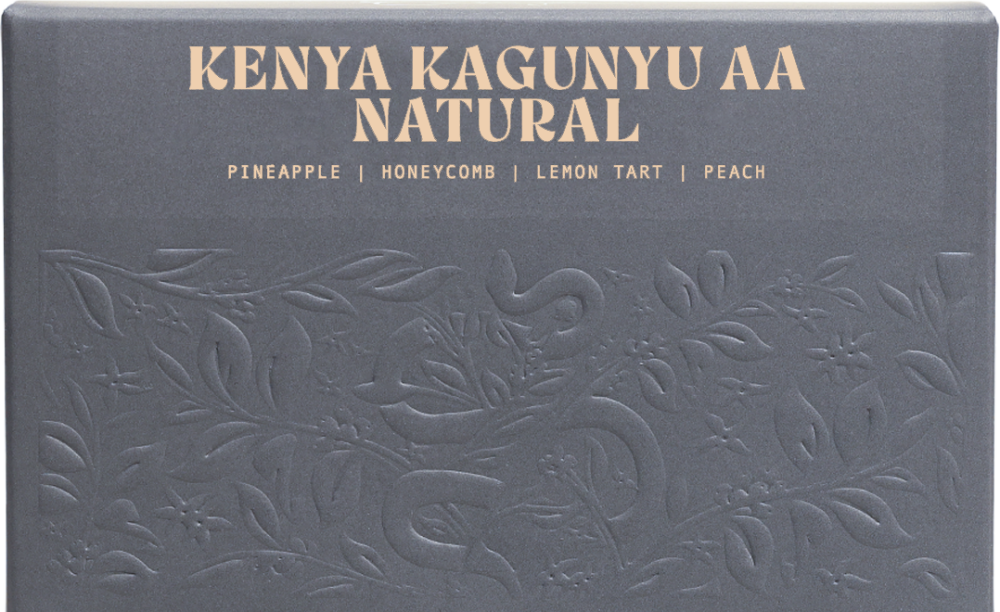Story
Kenya naturals, contrary to what you may believe, have been in existence for a long while. The prevalence of washed coffees has long kept the quality of these naturals low, due mostly to protocol and crowded drying bed space during harvest. Naturals, when properly dried, require a lot of drying bed space to dry for a long time, taking up to 14-20 days to finish drying. All this leads to the deprioritization of naturals over more commercially viable washed coffees. During our last visit to Kenya, we stopped by KCCE, a cooperative society focusing on exportation and marketing coffees directly for producers. Over the course of a day, we cupped hundreds of coffees, representing microlots from single producers to large estate coffees. The final table consisted of naturals and experimental anaerobic naturals, the standouts being traditional naturals from Thunguri and Kagunyu, which we contracted on the spot.
Kagunyu Station
As a part of the Rumukia Coffee Farmer Society in Nyeri, the Kagunyu station is located on the Karatina region. Like most of the coffee produced in this region, these coffees are grown by small-holder farmers located at the foothills of Mt. Kenya and Aberdare. These producers are much like smaller farmers located elsewhere in the world, growing produce which will consist of a much larger lot once it’s processed. For this particular natural, red ripe cherries were selected and floated to separate out the less dense floaters to ensure high quality in the end cup. Read more on processing below.
NATURALLY PROCESSED COFFEE
Natural coffees are beautiful… Okay, natural coffees are beautiful when done properly, but can be equally terrible when things go wrong. Natural processing, or dry processing, refers to the act of drying and fermenting coffee inside the cherry. Long before the age of portafilter tattoos and dual-boiler home espresso machines, coffee was picked and dried this way out of convenience. It is, to this day, still the most convenient and economically friendly way to process coffee cherries. (It’s estimated that dry-processing can use up to 90% less water than the washing process.) So why isn’t all coffee processed this way? Well, as coffee made its way across the world, it was commoditized and standardized, just like all other products spread by colonialism, but that’s a whole other story... Adding to the boom of washed processing, the natural process method can be tricky to get right, due to the delicate nature of fermentation and drying. What does all this have to do with the final cup? Well, when you leave the skin and fruit of the coffee cherry on the seed throughout fermentation and drying, that fruit begins to break down, imparting esters that influence delicate florals and big fruit notes into the seed that survive the roasting process. If it’s rushed or handled incorrectly, this fruit rot can lend off-flavors to the coffee, making the final cup “dirty” or “fermenty.”
How is this done? It starts at harvest, with the selective harvesting of ripe coffee cherries. Only the fully mature cherries are picked, as they have the highest sugar content and flavor potential. The harvested cherries are then sorted to remove any damaged or under ripe cherries. This ensures that only the best quality cherries are used in the primary fermentation. After sorting, the cherries are spread out in thin layers on large drying beds or patios to dry naturally under the sun. (or sometimes under shade) They are periodically raked and turned to ensure even drying. This step can take several weeks depending on weather conditions. As the cherries dry, they undergo a natural fermentation process. Enzymes present in the fruit interact with the sugars and other compounds, causing chemical reactions that impact the flavor profile of the coffee. This fermentation adds complexity and fruity flavors to the final cup. During the drying/ fermentation process, the cherries must be protected from rain, humidity, pests, and mold. Farmers often cover the cherries with tarps during the night or when there's a risk of adverse weather. The coffee cherries are dried until they reach an optimal moisture content of around 11-12%. At this point, the cherries have shrunk, and the outer skin and fruit can be easily removed to reveal the green coffee seed inside, which is ready for roasting after a short boat ride. Basically, that single cherry begins to slowly decay, and controlling that delicate action through advanced technique and metrics allow us, lucky folks, to drink wonderfully floral and fruity coffees.





